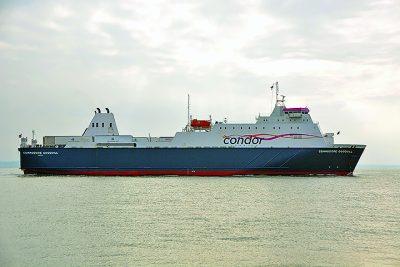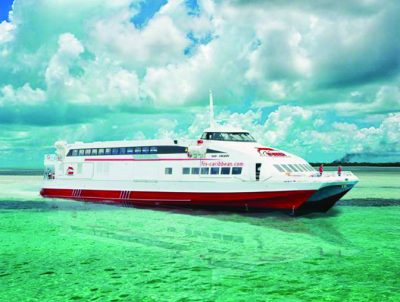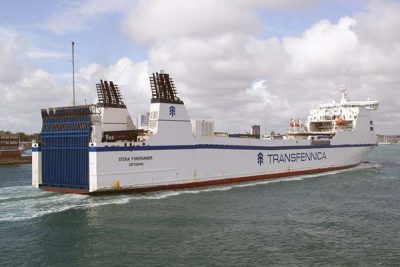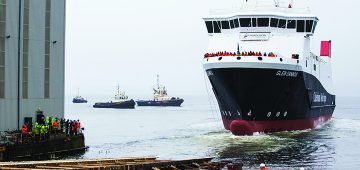Bay Ferries’ Portland-Nova Scotia service, marketed as The Cat, looks to be under threat as a result of Customs officials not providing the required inspection services in 2018 unless Portland’s facilities are upgraded, but the city is struggling to accept the asking price of $7 million. Portland officials say the city will not invest such a huge sum of money at the city’s Ocean Gateway terminal despite the Federal Government’s demands. Customs and Border Protection agreed in 2014 to operate a two-year temporary screening facility at Ocean Gateway when ferry service between Portland and Yarmouth, Nova Scotia, resumed after a four-year hiatus, but permanent facilities have not been forthcoming. An investment of that size may also be out-of-scale for the ferry, especially when compared with the economic gains of increasing cruise ship traffic to Portland. In the past four years, cruise ships have paid $5.63 million in passenger fees to the city, compared with $672,250 from Bay Ferries.
B.C. Ferries’ recently retired 4,939gt/1964 built Queen of Nanaimo (above) completed an epic trans-Pacific journey to her new home in Fiji on 27th November as the third of the ferry corporation’s vessels to find service with Goundar Shipping Ltd. Capable of carrying 164 cars and 1,005 passengers and crew, the Queen of Nanaimo served the Tsawwassen and Southern Gulf Islands route for three decades, but suffered maintenance problems with a propeller that kept her out of service and prompted an earlier-than-expected retirement of the vessel. The Queen of Nanaimo was expected to enter service on 11th December as the Lomaiviti Princess V. The company already operates the former Queen of Prince Rupert, re-christened as the Lomaiviti Princess I , and bought the former Queen of Chilliwack in 2014.
Condor Ferries’ 11,166gt/1996 built Commodore Goodwill (above) encountered mechanical problems on 21st November due to extensive cracks in the starboard engine turbocharger and had to be assisted into St. Helier harbour by the resident tug. This had a knock-on effect on the 14,000gt/1999 built Commodore Clipper which then had to cover for both daily conventional sailings and deal with bad weather disruption that same week. The latter had also suffered a technical issue of her own that had caused delays on 18th/19th November. The ‘Goodwill proceeded to Southampton’s western docks for repairs. A 24 hour delay in supplies reaching the Islands then followed with the Co-Op probably wishing that it had not disposed of warehouses vital at times of bad weather or mechanical issue disruption.
Detroit World Logistic Maritime S.A’s 12,175gt/1980 built Le Rif was expected to depart from Naples at the end of November to enter service on the TangerMed-Algeciras service following refit at Genoa. The ship began life as Sealink’s Galloway Princess and now carries a livery that mirrors her original Sealink colours.
European Seaways’ 10,553gt/1979 built Galaxy was chartered by Traghetti delle Isola for the Trapani-Pantelleria service in Sicily to replace the mechanically troubled 9,183gt/1974 built ferry Lampedusa. The Galaxy sailed from Perama on 17th November bound for Trapani.

Fjord Line’s 31,678gt/2013 built Stavangerford and 2014 built sistership Bergensfjord are receiving a 20% increase in their passenger capacity following an increase in demand on the Bergen-Stavanger-Hirtshals-Langesund services. Sixty cabins are being installed on Deck 10 and the buffet restaurant seating is being increased by 125 seats. The Stavangerfjord was the first ship to be dealt with in November/December 2017 at the Bergen Group Fosen AS Shipyard while the Bergensfjord is being upgraded in January/ February 2018. When delivered the ships could accommodate 1500 passengers and 600 cars and offered 306 cabins.
FRS Caribbean resumed sailings to Bimini on 27th September following Hurricane Irma and, on 9th November, the company launched a new service between Miami and Freeport, Grand Bahama, using the 992gt/2001 built passenger catamaran San Gwann (above). The journey time to Grand Bahama is 3 hours and the journey to Bimini is 2 hours. Meanwhile the former 910gt/2003 built FRS Helgoline vessel Halunder Jet was renamed Clipper V and loaded aboard the 11,473gt/2010 built freighter Palabora at Emden for the voyage to British Columbia and her new career.
Moby Line’s 34,093gt/1981 built Moby Dada (previously the Queen of Scandinavia/Princess Maria) finally departed Barcelona for Piombino on 16th November after 57 days acting as accommodation for Spanish police officers. With peak season over, the personnel were able to use hotels. The same day the 30,318gt/ 1981 built GNV Azzurra (ex-SNAV Toscana/Peter Wessel) moved from Tarragona to Barcelona to continue her charter as a floating hotel in the company of the 44,307gt/1996 built Rhapsody. Their employment as hotels was expected to end around 12th January 2018.
Seaborne Freight (not to be confused with UK based Seabourne Freight) appears to be on track to open a Ro-Ro service between Ostend and Ramsgate as from May 2018. The company has earmarked a trio of ferries for the service but the one generating the most interest is the Al Andalus Express. The ship began life in 1987 as SNCF’s 13,727gt Dover-Dunkerque trainferry Nord pas de Calais. She spent her life serving Dover for SNCF, Seafrance and MyFerryLink before withdrawal and charter to FRS Iberia for use on their TangerMed-Motril service from 2016. It will be very pleasing indeed to see her back at a UK port.
Stena Line announced in November that the second ship for the Harwich-Rotterdam service will be the 24,688gt/2003 built Stena Forerunner (above), joining the 13,017gt/1996 built Stena Scotia. These ferries will replace the chartered 1,755 lanemetre capacity and 16,342gt/2011/2012 built CLdN (Cobelfret) ships Capucine and Severine. The charter of the CLdN vessels was due to expire at the end of 2017.
Viking Line has contracted Finnish technology group Wärtsilä to supply engines, navigation system, and a broad scope of other products and systems for Viking Line’s new environmentally friendly ferry. The ship, which is being built at the Xiamen Shipbuilding Industry yard in China, will be powered by six Wärtsilä 31DF dual-fuel engines running primarily on LNG. The combination of high efficiency, low fuel consumption, and the reduced level of exhaust emissions from operating on LNG, is expected to create low operating costs and a minimal environmental footprint. Viking Line signed a conditional shipbuilding contract, amounting to a total of €194 million, for the vessel in April 2017. The deal includes an option for another ship. Scheduled for delivery in 2020, the vessel will be deployed on the Turku-Åland Islands–Stockholm route. Viking Line’s first LNG powered ferry, the Viking Grace, was fitted with Wärtsilä dual-fuel engines and became the world’s largest Ro-Pax ferry to operate on this clean fuel.

Wightlink won Best Family Ferry Operator 2017 and was presented with the award at the third annual Family Traveller awards ceremony on 21st November. Attracting a record 45,000 votes from the popular magazine and website’s readership, every element of a family trip was voted on by readers, with results highlighting what parents are looking for when planning and booking a holiday.








Comments
Sorry, comments are closed for this item